Effect of Bamboo Nodes on the Mechanical Properties of Phyllostachys iridescens
Abstract
1. Introduction
2. Materials and Methods
2.1. Materials
2.2. Test Methods
3. Results
3.1. Compressive Strength Parallel to Grain
3.2. Shear Strength Parallel to the Grain
3.3. Radial Stiffness
3.4. Impact Toughness
3.5. Bending Properties
3.6. Tensile Properties Parallel to Grain
4. Conclusions
Author Contributions
Funding
Data Availability Statement
Conflicts of Interest
References
- Li, H.; Zheng, X.; Guo, N.; Sheng, Y. Modern Bamboo & Wood Buildings; Architecture Publishing & Media Co. Ltd.: Beijing, China, 2020. [Google Scholar]
- Yi, P.; Li, J.; Li, J.; Qin, N.; Tang, L.N. Application of the Modern Bamboo in Building Structure. J. Chongqing Jianzhu Univ. 2011, 33 (Suppl. S2), 115–118. [Google Scholar]
- Jia, S.; Wang, Y.; Wei, P.; Ma, X.; Wu, Y. Structure and Mechanical Properties of Bamboo Nodes: A Review of Current Research. World Bamboo Ratt. 2024, 22, 90–99. [Google Scholar]
- Luan, Y.; Yang, Y.; Jiang, M.; Liu, H.; Ma, X.; Zhang, X.; Sun, F.; Fang, C. Unveiling the mechanisms of Moso bamboo’s motor function and internal growth stress. New Phytol. 2024, 243, 2201–2213. [Google Scholar] [CrossRef]
- Li, Z.; Chu, S.; Qin, L.; Lin, L. Influence of node on the bonding properties of glued laminated bamboo. J. For. Eng. 2022, 7, 80–85. [Google Scholar]
- Xia, M.; Chen, A.; Yu, F. The Effect of the Node on the Development of Ground Tissue Cell Walls during the Rapid Elongation Growth of Phyllostachys edulis ‘Pachyloen’ Culm. Acta Agric. Univ. Jiangxiensis 2018, 40, 1178–1184. [Google Scholar]
- Chen, Q.; He, Y.; Jiang, Y.; Qi, J.; Zhang, S.; Huang, X.; Chen, Y.; Xiao, H.; Jia, S.; Xie, J. Effect of bamboo nodes on crack generation of round bamboo and bamboo-based composites during drying. Eur. J. Wood Prod. 2023, 81, 1201–1210. [Google Scholar] [CrossRef]
- Shi, J.; Li, Z.; Chen, H.; Wu, Z.; Ji, J.; Xia, C.; Zhong, T. Tunable bending characteristics of bamboo by regulating moisture content for bamboo curved component manufacturing. Ind. Crops Prod. 2024, 221, 119365. [Google Scholar] [CrossRef]
- Chen, Q.; He, Y.; Lai, S.; Qi, J.; Zhang, S.; Jia, S.; Xiao, H.; Chen, Y.; Jiang, Y.; Fei, B.; et al. 3D characterization of vascular bundle in moso bamboo node and its effect on compressive properties. Holzforschung 2023, 77, 368–377. [Google Scholar] [CrossRef]
- Xu, K. Experimental Study on the Mechanical Properties of Round Bamboo-Light Mortar Composite Wall. Master’s Thesis, Xi’an University of Architecture and Technology, Xi’an, China, 2014. [Google Scholar]
- Widjaja, E.; Riayad, Z. Anatomical. Properties of Some Bamboos Utilized in Indonesia. In Chouinard Bamboo Research in Asia; Lessard, G., Ed.; IDRC: Ottawa, ON, Canada, 1980; pp. 244–249. [Google Scholar]
- Murphy, R.J.; Alvin, K.L. Variation in fiber wall structure in bamboo. IAWA Bull. 1992, 13, 403–410. [Google Scholar] [CrossRef]
- Ghavami, K.; Garcia, J.J.; Torres, L.A. A Transversely isotropic law for the determination of the circumferential Young’s Modulus of bamboo with diametric compression tests. Lat. Am. Appl. Res. 2007, 37, 255–260. [Google Scholar]
- LY/T2564-2015; Test Method for Physical and Mechanical Properties of Round Bamboo. Standards of China: Beijing, China, 2015.
- GB/T 1927.17-2021; Test Methods for Physical and Mechanical Properties of Small Clear Wood Specimens-Part 17: Determination of Impact Bending Strength. General Administration of Quality Supervision, Inspection and Quarantine of the People‘s Republic of China: Beijing, China, 2021.
- Hao, J.; Qin, M.; Tian, L.; Liu, M.; Zhao, Q.L. Experimental research on the mechanical properties of Phyllostachys pubescen along the grain direction. J. Xi’an Univ. Archit. Technol. 2017, 49, 777–783. [Google Scholar]
- Lin, F.; Chen, Y.; Dai, Z.; Liu, M.; Zhang, Q. Experimental Study on the Effect of Bamboo Nodes on the Pressure Resistance of Bamboo. J. Bamboo Res. 2019, 38, 72–77. [Google Scholar]
- Shao, Z.; Huang, S.; Wu, F.; Liu, Y.M.; Arnaud, C. A Study on the Difference of Structure and Strength between Internodes and Nodes of Moso Bamboo. J. Bamboo Res. 2008, 27, 48–52. [Google Scholar]
- Mouka, T.; Dimitrakopoulos, E.G.; Lorenzo, R. Effect of a longitudinal crack on the flexural performance of bamboo culms. Acta Mech. 2022, 233, 3777–3793. [Google Scholar] [CrossRef]
- Yu, J.; Hao, J.; Tian, L. The study on the main influencing factors and mechanical properties of Phyllostachys pubescens. J. Xi’an Univ. Archit. Technol. 2018, 50, 30–36. [Google Scholar]
- Han, S.; He, Y.; Ye, H.; Chen, F.; Liu, K.; Shi, Q.S.; Wang, G. Mechanical Behavior of Bamboo, and Its Biomimetic Composites and Structural Members: A Systematic Review. J. Bionic. Eng. 2024, 21, 56–73. [Google Scholar] [CrossRef]
- Al-Rukaibawi, L.S.; Károlyi, G. Through-thickness distribution of bamboo tensile strength parallel to fibres. SN Appl. Sci. 2023, 5, 174. [Google Scholar] [CrossRef]
- Li, S.; Liu, C.; Wang, Y.; Shang, L.; Liu, X.; Wang, S.; Yang, S. Three-dimensional visualization of the conducting tissue in a bamboo culm base. Wood Sci. Technol. 2024, 58, 1585–1603. [Google Scholar] [CrossRef]
- Li, X.; Zhong, T.; Chen, H.; Li, J. Chemical composition and thermal stability of cells in different structures of Phyllostachys edulis. J. Beijing For. Univ. 2023, 45, 156–162. [Google Scholar]
- Pi, X.; Tie, Y.; Hu, M. Anti-impact performance of plain woven composite patching structure based on multi-scale analysis. J. Vib. Shock. 2022, 41, 188–197. [Google Scholar]
- Pruksawan, S.; Lim, J.W.R.; Lee, Y.L.; Lin, Z.; Chee, H.L.; Chong, Y.T.; Chi, H.; Wang, F. Enhancing hydrogel toughness by uniform cross-linking using modified polyhedral oligomeric silsesquioxane. Commun. Mater. 2023, 4, 75. [Google Scholar] [CrossRef]
- Qin, W.; Yu, H.; Xu, M.; Zhuang, X.; Wang, H.; Ying, M.; Pan, X.; Liang, Y. Effects of microwave softening treatment on dynamic mechanical and chemical properties of bamboo. J. Mater. Sci. 2024, 59, 3488–3503. [Google Scholar] [CrossRef]
- Mehramiz, S.; Oladi, R.; Efhamisisi, D.; Pourtahmasi, K. Natural durability of the Iranian domestic bamboo (Phyllostachys vivax) against fungal decay and its chemical protection with propiconazole. Eur. J. Wood Prod. 2021, 79, 453–464. [Google Scholar] [CrossRef]
- Shi, J.; Li, Z.; Chen, H.; Wu, Z.; Ji, J.; Xia, C.; Wang, H.; Zhong, T. Optimizing processing strategies for eco-friendly bamboo curved components: Insights from bamboo internode and node differences. Ind. Crops Prod. 2024, 216, 118823. [Google Scholar] [CrossRef]
- Yang, X.; Zhang, F.; Huang, Y.; Fei, B. Tensile and bending properties of radial slivers of Moso bamboo. J. Beijing For. Univ. 2022, 44, 140–147. [Google Scholar]
- Liu, C.; Xizhi, W.; Li, X.; Liu, X. Structure and physical properties of high-density bamboo scrimber made from refined bamboo bundles. Eur. J. Wood Prod. 2024, 1–12. [Google Scholar] [CrossRef]
- Ma, Z.; Cai, C.; Yin, Y.; Dang, J.; Ming, W.; An, Q.; Chen, M.; Liu, G.; Li, J. Vibration characteristics and machining performance of carbon fiber reinforced shaft in poor rigidity machining tool system. Int. J. Adv. Manuf. Technol. 2024, 134, 2637–2652. [Google Scholar] [CrossRef]
- Chan, C.H.; Wu, K.J.; Young, W.B. The effect of densification on bamboo fiber and bamboo fiber composites. Cellulose 2023, 30, 4575–4585. [Google Scholar] [CrossRef]
- Su, Q.; Huang, A.; Chen, X.; Dai, C.; Fei, B.; Fang, C.H.; Ma, X.; Sun, F.; Zhang, X.; Liu, H. Anisotropic tensile performance of bamboo parenchyma tissue and its influencing factors. Cellulose 2023, 30, 9147–9160. [Google Scholar] [CrossRef]
- Qi, J.; Xie, J.; Yu, W.; Chen, S. Effects of characteristic inhomogeneity of bamboo culm nodes on mechanical properties of bamboo fiber reinforced composite. J. For. Res. 2015, 26, 1057–1060. [Google Scholar] [CrossRef]
- Wang, Z.; Li, H.; Yang, D.; Xiong, X.; Sayed, U.; Lorenzo, R.; Corbi, I.; Corbi, O.; Hong, C. Bamboo node effect on the tensile properties of side press-laminated bamboo lumber. Wood Sci. Technol. 2021, 55, 195–214. [Google Scholar] [CrossRef]
- Xue, J.T.; Bai, Y.; Peng, L.; Huang, X.B.; Sun, Z.Y. Exploring the Interplay between Local Chain Structure and Stress Distribution in Polymer Networks. Chin. J. Polym. Sci. 2024, 42, 874–885. [Google Scholar] [CrossRef]

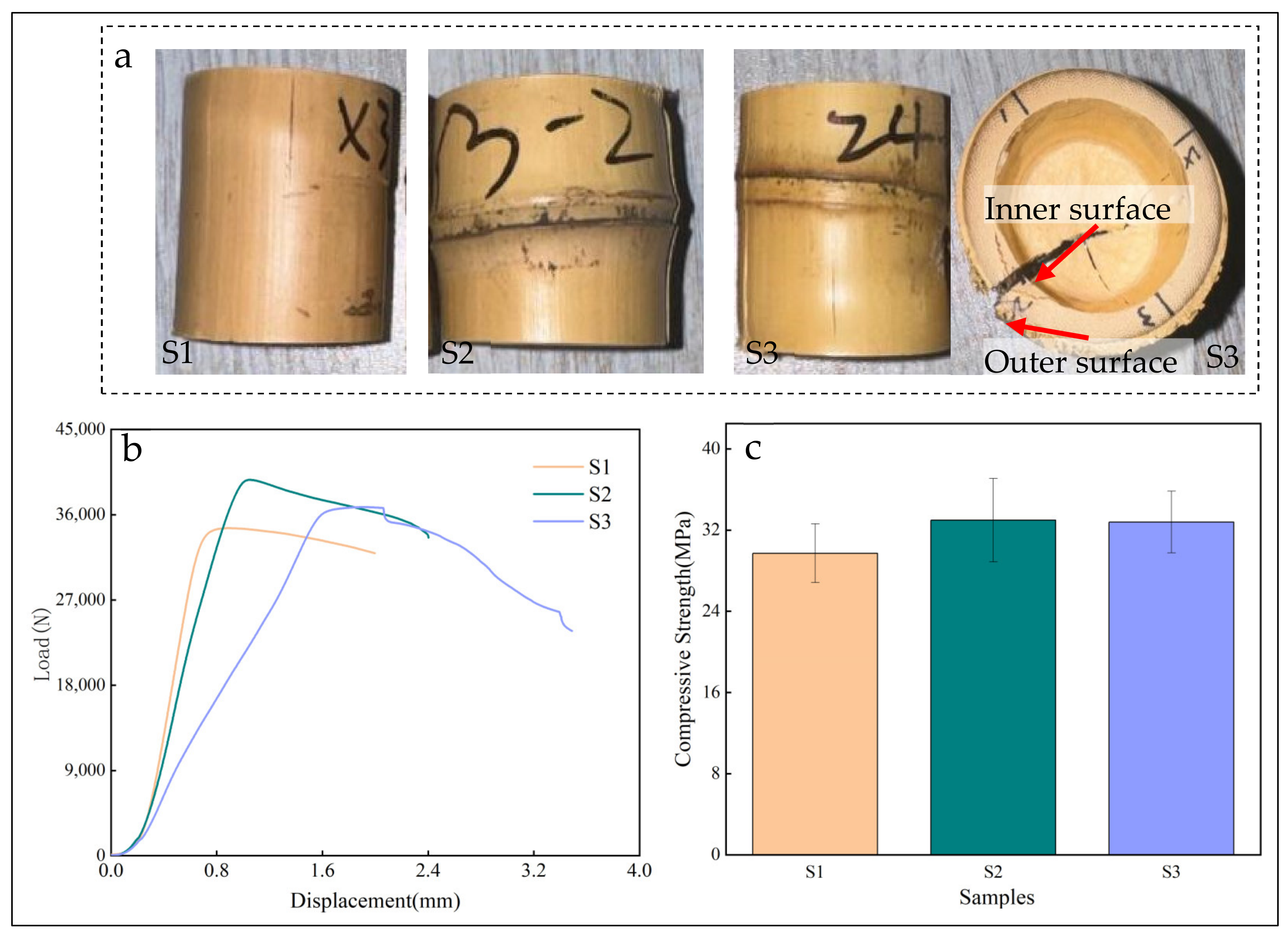
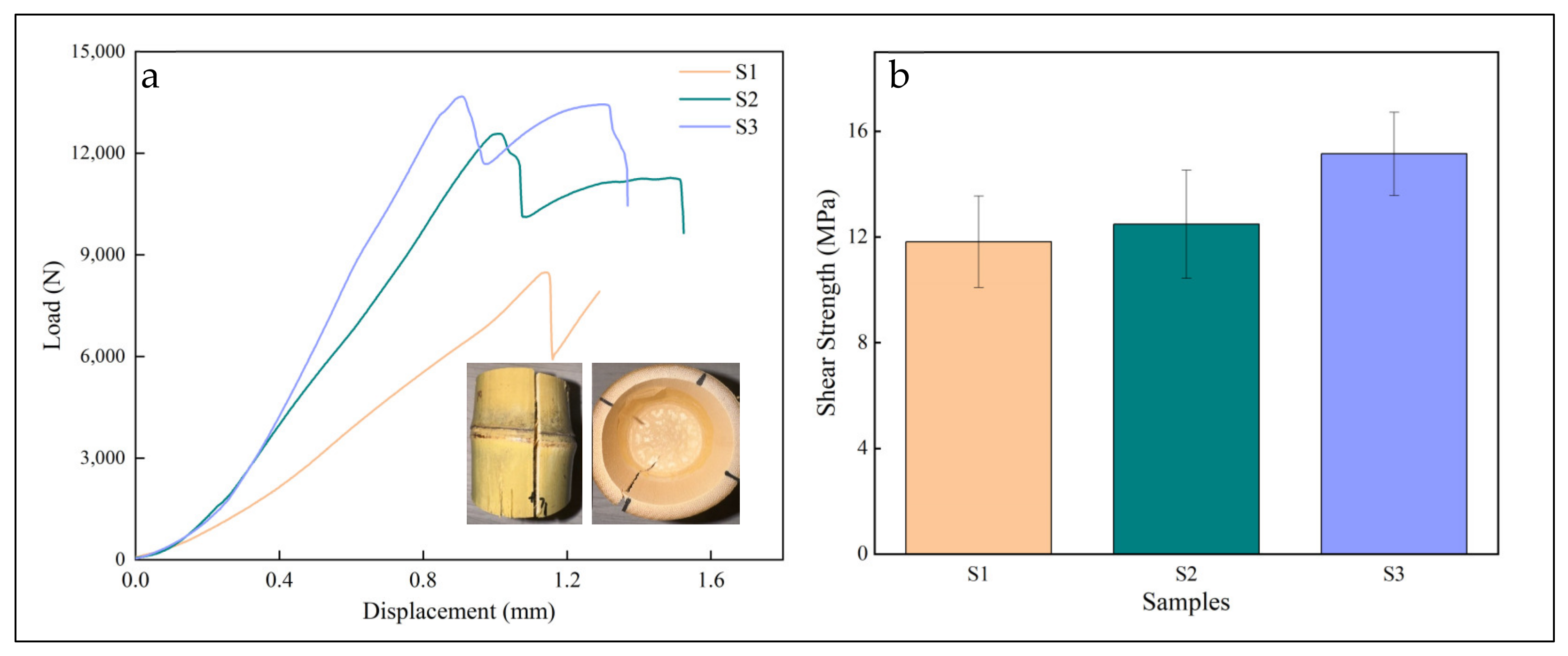
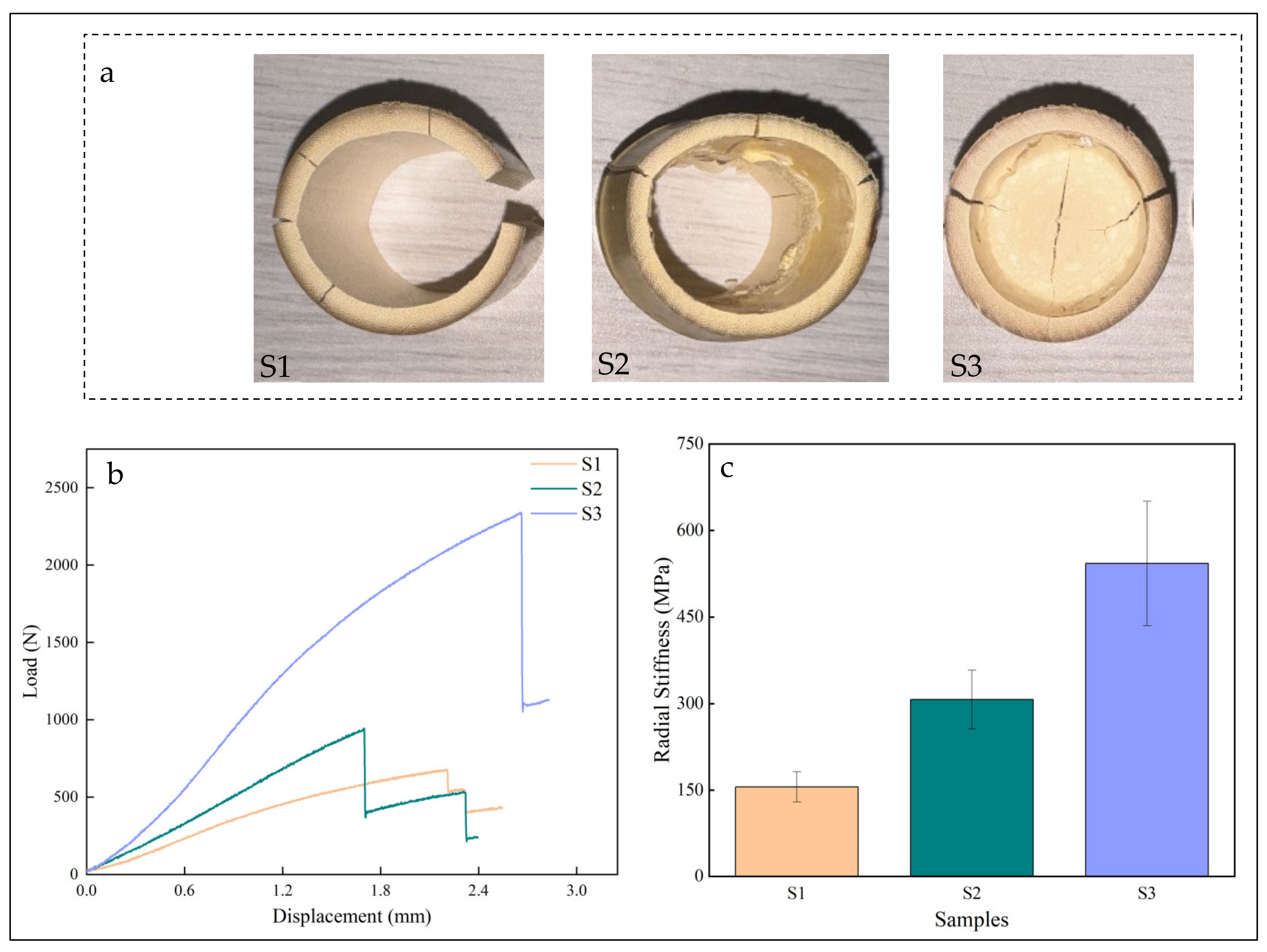
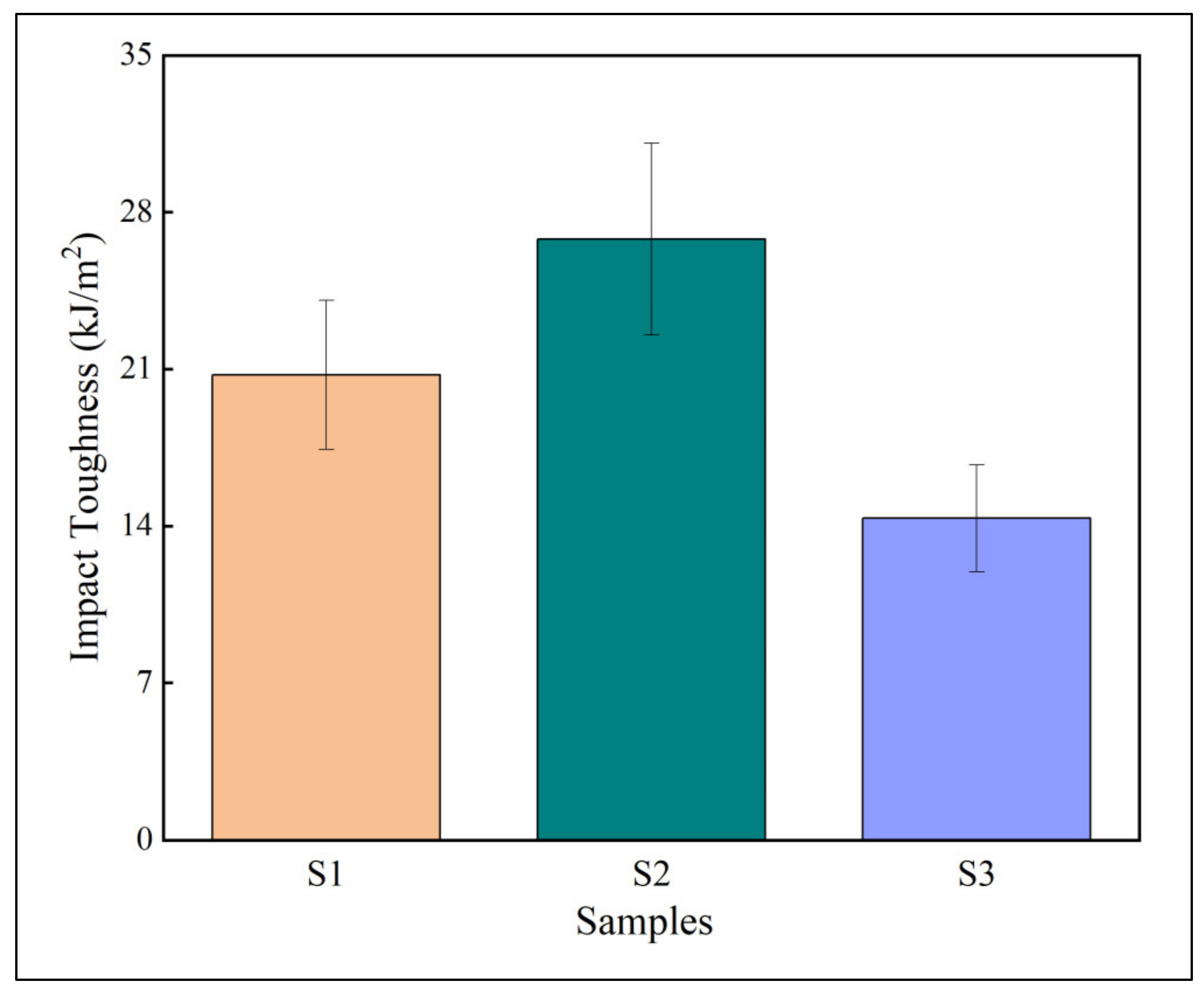
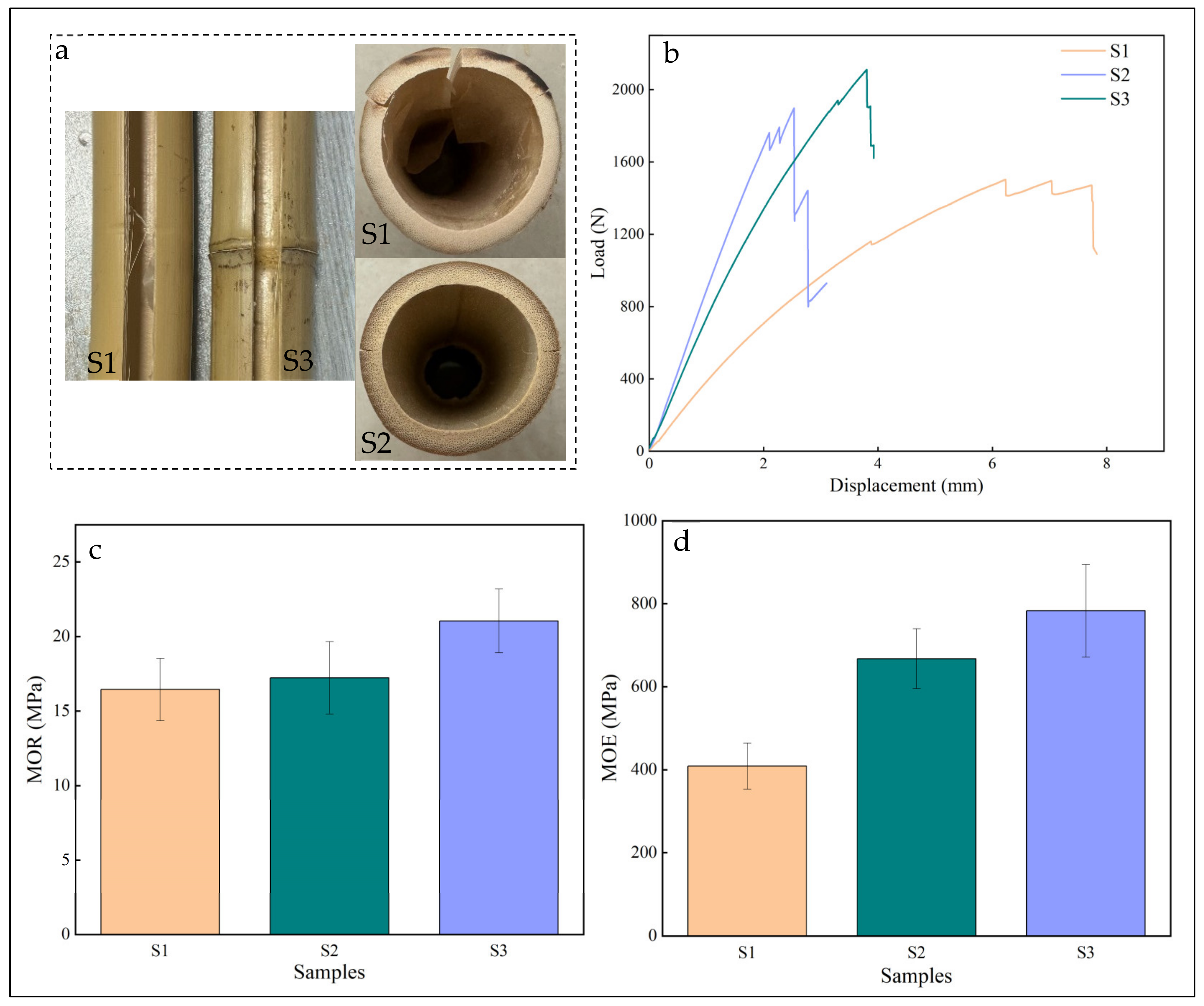

Disclaimer/Publisher’s Note: The statements, opinions and data contained in all publications are solely those of the individual author(s) and contributor(s) and not of MDPI and/or the editor(s). MDPI and/or the editor(s) disclaim responsibility for any injury to people or property resulting from any ideas, methods, instructions or products referred to in the content. |
© 2024 by the authors. Licensee MDPI, Basel, Switzerland. This article is an open access article distributed under the terms and conditions of the Creative Commons Attribution (CC BY) license (https://creativecommons.org/licenses/by/4.0/).
Share and Cite
Wang, X.; Yu, S.; Deng, S.; Xu, R.; Chen, Q.; Xu, P. Effect of Bamboo Nodes on the Mechanical Properties of Phyllostachys iridescens. Forests 2024, 15, 1740. https://doi.org/10.3390/f15101740
Wang X, Yu S, Deng S, Xu R, Chen Q, Xu P. Effect of Bamboo Nodes on the Mechanical Properties of Phyllostachys iridescens. Forests. 2024; 15(10):1740. https://doi.org/10.3390/f15101740
Chicago/Turabian StyleWang, Xuehua, Siyuan Yu, Shuotong Deng, Ru Xu, Qi Chen, and Pingping Xu. 2024. "Effect of Bamboo Nodes on the Mechanical Properties of Phyllostachys iridescens" Forests 15, no. 10: 1740. https://doi.org/10.3390/f15101740
APA StyleWang, X., Yu, S., Deng, S., Xu, R., Chen, Q., & Xu, P. (2024). Effect of Bamboo Nodes on the Mechanical Properties of Phyllostachys iridescens. Forests, 15(10), 1740. https://doi.org/10.3390/f15101740




